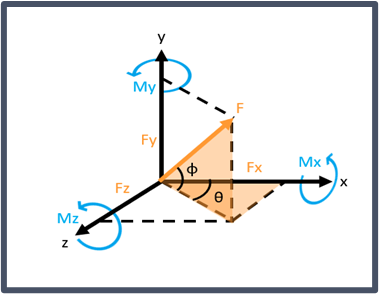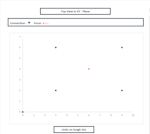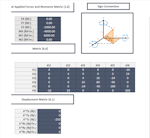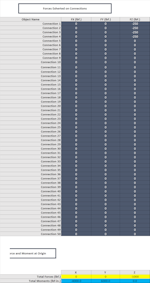Reaction Force Check 2.0

Description
Spreadsheet is able to find the x,y,z reaction forces of various fixed connections or bolt patterns in 3-dimensions using vector statics.
First, define if point is a resultant location or a load. The spreadsheet can have up to 20 loads and/or 50 connections.
Type 'O#' to create a load. Type 'C#' to create a connection/bolt in the 'Part No.' light blue column.
Next add the coordinates x,y,z of the load or connection in the following X,Y, and Z light blue columns.
If a load is added, apply the load value in the orange 'FR' column.
The direction of the load is controlled by the 2 plane angles 'phi' and 'theta' in the following orange columns. Reference the axis orientation figure to input the current angle values.
Last, the user will need to insert the total amount of connections to in the neon blue coloured cell. The matrix will not provide correct values if this value is wrong.
The user should not update the dark blue cells or sheet 2.
The program will plot the loads and connections in an 2-D (X-Y plane) plot. The user will be able to see the location and directions of the loads and connections.
The program will create a 3-D vector matrix of the loads and connections to find the resultant reaction forces. Reference the 'Forces Exerted on Connections' table for the results.
The user can then use these forces to simplify other static problems or solve bolt stresses.
This spreadsheet leverages principles of 3D vector statics to analyse reaction forces in structural connections subjected to complex loading. Defining the geometry and loading is intuitive - you simply specify coordinate points representing connections ('C#') and applied loads ('O#'), along with magnitude and direction angles for the loads.
Under the hood, the spreadsheet sets up and solves the 3D statics matrix equation, computing the x, y, and z reaction force components at each defined connection point needed to maintain equilibrium with the applied loads. This eliminates the need for the user to setup and solve these complex matrix calculations manually.
The output reaction force table, along with the 2D graphical plot showing the connection points and load directions, provides the user clear insights into how the structural system redistributes the loading.
With an understanding of the interplay between loads and connection reactions, the user can simplify downstream analyses. For example, identifying the most heavily loaded connections for detailed bolt stress evaluation, or determining net loading for beam analysis.
By automating the intensive computations, the spreadsheet provides an easy-to-use and visually intuitive platform for gaining key engineering insights from 3D structural loading scenarios. The modular framework accepts flexible problem definition and is scalable to sizable connection networks and loading conditions.
Calculation Preview
Full download access to any calculation is available to users with a paid or awarded subscription (XLC Pro).
Subscriptions are free to contributors to the site, alternatively they can be purchased.
Click here for information on subscriptions.





